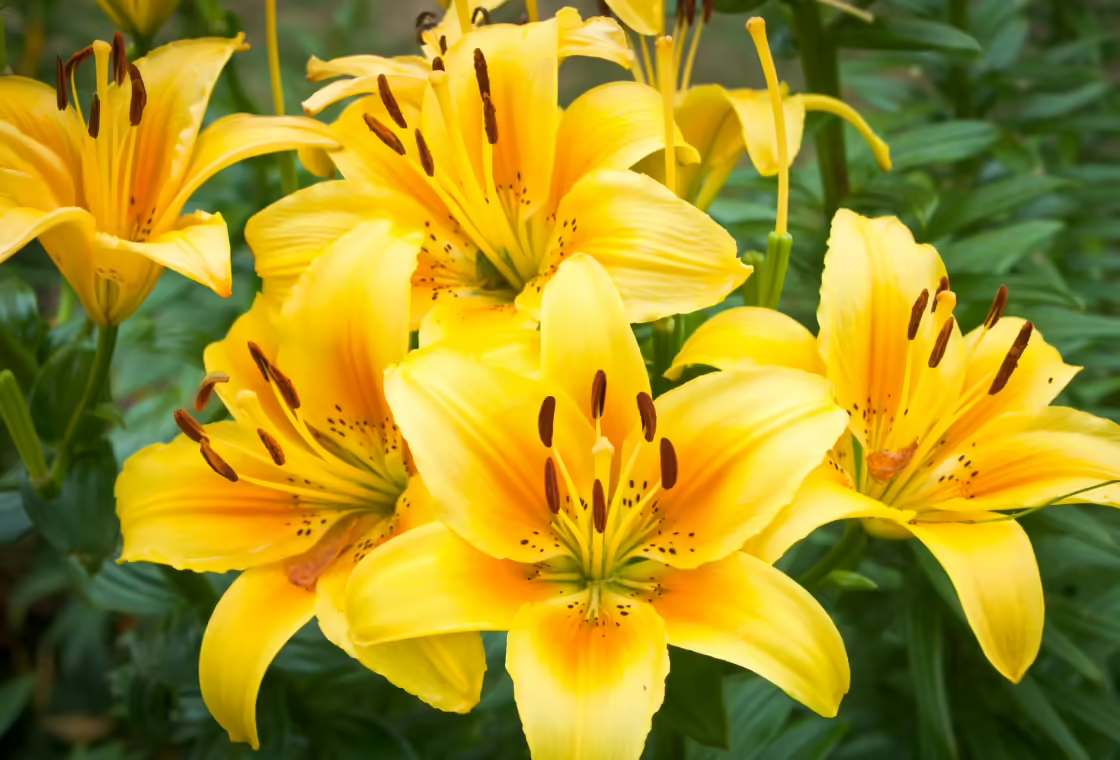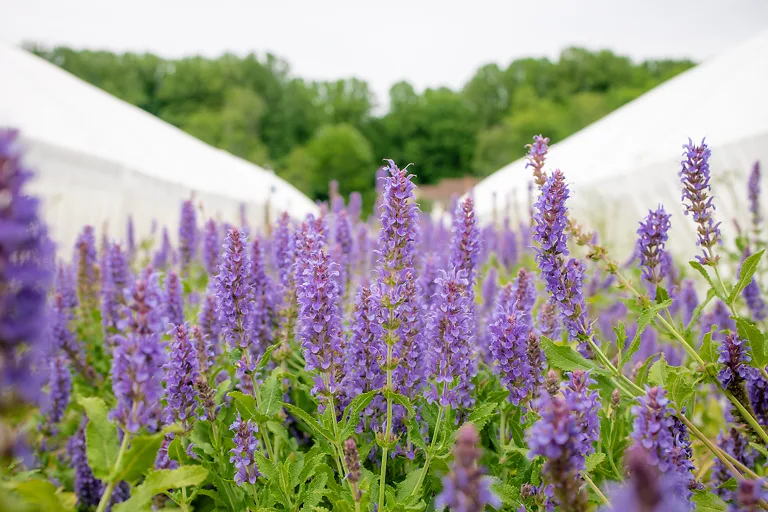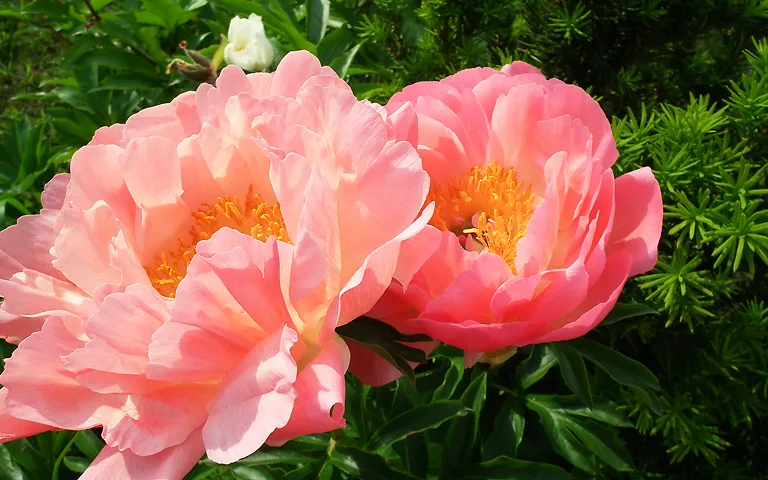
Written by s • Daylilies – the Best Summer Flower for Your Garden
The old-fashioned orange daylily, with its tall stems and narrow orange trumpets, has been grown in gardens for many, many, years. It is often seen in old, neglected ones, or growing along roadsides, and there are probably many who see it as a wild flower. Called Hemerocallis fulva, its original home was in China, though, and with the yellow daylily (Hemerocallis lilioasphodelus), these original plants have been around since the 16th century.
Although loved, the tall flower stems, limited flowering period and tendency to spread alarmingly make them ‘less than idea’ plants for gardens. Starting early last century, and peaking in the second half, this plant caught the attention of amateur and professional plant breeders, who created a whole tribe (over 20,000 have been registered) of glorious plants that make ‘daylily season’ the highlight of summer. Although most of those varieties are of interest only to collectors, there is a host that are amazing garden plants. If you want a knock-out summer of blooms in your garden, on plants that are easy to grow, adaptable and tough, then daylilies should be in your garden.
Why Daylilies are Such a Great Choice
- Come in a wide range of colors
Today the only color that you can’t find in a daylily is blue. Most come in the yellow part of the spectrum, ranging from almost pure white though every shade of yellows, oranges, and many reds, plus a few purples. These are fabulous colors for summer, shining like the sun – let the sky add the missing blues! Combine that with shorter flower stems, and many more buds, blooms lasting just one day are no longer a problem. There are bi-colors too, and ones with contrasting throat colors as well.
- Quickly make a bold display
Plant shrubs and trees and you wait several years – even a decade – to see the results, and to have plants that look like the catalogue specimens that guided you. With daylilies (and most other perennial plants except for peonies) it takes just a couple of seasons for them to grow to their full size, with a substantial presence, giving you a great display in such a very short time-frame.
As well, if you choose reblooming varieties that display goes on for weeks and even months. Many shrubs and trees look good for just a couple of weeks of the year, while the best daylilies just keep going and going. As well (and as a nursery we probably shouldn’t tell you this) within a few years you can divide your plant, multiplying it into several new ones that in turn quickly mature. That makes buying perennials a real bargain, compared to buying shrubs.
- Thrive in hot, dry places
Daylilies could probably be called ‘sun-lilies’, they love it so much. For maximum blooming and reblooming, plant in full sun. After a little extra watering in their first summer, they thrive in heat and tolerate a lot of dryness. They are also happy in very poor soils – although, OK, they will grow best in richer ones – and make great plants for tough urban gardens, drier sandy soils, rocky and gravel soils, and other difficult places to fill. The only thing they don’t like are wet feet, so don’t plant in low-lying and boggy parts of your garden.
- Grow in every climate zone
Perhaps one of the most remarkable things about daylilies is how cold resistant they are, and yet how well they grow in hot zones. Few plants can be grown from zone 3 right through into zone 9, but daylilies can be. Yes, there are some varieties that do better in the north, and others that do better in the south, but they pretty much all do fine everywhere. Daylily varieties come in two categories, depending on what parent species were used. Some are ‘deciduous’, dying back completely in fall. Others are ‘evergreen’, sending up new leaves beside the old clump as soon as it begins to die down. Generally, if you garden in colder zones, it is best to choose deciduous varieties, while in the South you might want to go for evergreens, since they will have their attractive leaves pretty much year-round.
- Need almost no attention
Once you have them established, daylilies only need attention a couple of times a year. Most people like to cut out the old flower stems, once the last buds have opened, just for looks. It’s a quick and easy job if you have a strong, sharp pair of hand pruners (something every gardener should have). Then, in fall, simply cut down the foliage to an inch or two above the ground. In northern areas you should do that with them all, but warm zones it’s best to leave the foliage of the evergreen varieties uncut.
If you want to get fancy then a fall or spring mulch with some nice rich compost or other organic material will really give them a boost, and conserve moisture around the roots as well.
Extending the Season
The only ‘downside’ to daylilies is that many varieties only bloom for a few weeks. In very hot regions an individual plant can be over in a week – in cooler zones it can be 4 to 5 weeks. But with so many different varieties there are two solutions to this problem.
Choose a Range of Blooming Times
The first strategy for extending the daylily season in your garden is to pick your varieties with some care. Don’t just be swept away by a pretty face, but take a look at the season of bloom. Beginners might find that a bit odd, the answer is ‘summer’, right? But there is more to it than that. Specialist growers recognize seven different ‘zones’ in which different varieties bloom:
Extra Early – these varieties bloom in May in the north, and as early as March in zone 9.
Early – these bloom in April in hot areas, and during May in cooler ones.
Early Midseason – these are the prelude to the big display of most varieties, with blooms in May in the South and early June in the north.
Midseason – this is the time when most daylilies bloom, normally in June or July.
Late Midseason – these bloom 2 or 3 weeks after the main display.
Late – it is late summer before these varieties put on a show.
Very Late – there are not many of these, but very late summer and into fall is when they flower.
Since the majority of varieties are ‘midseason’, the trick is to use a range of those as the core of our daylilies, and then add early and late varieties, ideally planted in groupings for impact, to extend the season.
Grow Reblooming Varieties
Most daylilies send up a batch of bloom stalks, and that is it for the year. Some, though, come back with one, two or even three additional ‘flushes’ of stalks, meaning they are in bloom for weeks and weeks. These are great choices for smaller gardens, and for general landscaping, since they give the biggest bang for the space they occupy. You can grow a single plant in a small place, but groups of 3, 5 or more will both fill spaces with dense, weed-resisting foliage and give summer-long blooming.
There is a pretty long list of reblooming varieties, but top of the list must go to ‘Stella de Oro’, without doubt the most widely grown modern daylily. Its compact form and profusion of bright golden-yellow flowers, a little under 3 inches across are a feature of many landscapes, but that doesn’t mean you shouldn’t be growing it. Reliable and durable, it blooms in the midseason with a heavy blooming, and then, after a short break, a whole new crop of blooms appears. A great alternative is ‘Happy Returns’, another popular varieties that has its first bloom with the early varieties, and then returns for the midseason, and often again with a late crop. The flowers are lighter yellow than the gold of ‘Stella de Oro’, and a little larger too. For the best reblooming, full sun, richer soils and some summer watering are all needed.







